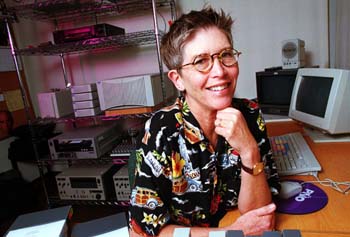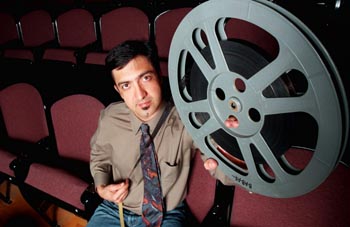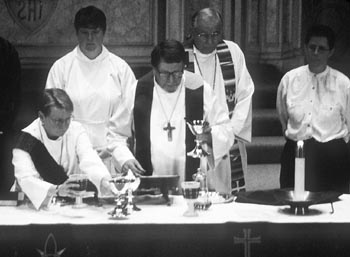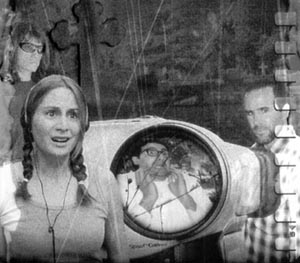![[Metroactive Movies]](/movies/gifs/movies468.gif)
[ Movies Index | Show Times | San Jose | Metroactive Central | Archives ]
 Staying Put: Filmmaker Pam Walton works out of her Mountain View garage and doesn't see any advantage to living in L.A. Think Globally, Film Locally These South Bay filmmakers swim against the L.A. tide I'VE BEEN A FILM critic for more than 20 years, and during that time I've noticed one constant of the movie industry: Business has always been bad, and it is always getting worse. Studios may trumpet the success of their products, but directors and actors usually don't. There is, however, one sure way to tell the difference between a movie that earns money and one that doesn't. When talking to a reporter, a filmmaker will describe disparagingly a movie that tanked as "that memorable film ..." (as in "I made my first appearance in that memorable film Insulting the Sultan"). If the movie made a trillion dollars, it's introduced as "a picture called ..." (as in "and then I made a picture called It's Nicer Lying Down, and the rest is history"). Aside from notorious cases like James Cameron, no one wants to attract the evil eye by boasting. So from the small walk-on to the famous star, everyone engages in poor-mouthing--summed up in Hollywood bookkeeping by the typical case of the $200 million blockbuster that, on paper, hasn't earned a cent. In this shifty milieu, in which hard numbers are as hard to pin down as an entry-level job, local filmmakers are under constant pressure to get out of town. Cinequest: The San Jose Film Festival, about to celebrate its 10th anniversary (Feb. 24-March 5), is luring back some former valleyites to exhibit their works. In cynical moments, it seems to me like a version of St. Patrick's Day, when everyone suddenly remembers that they're part Irish. But who can blame these homegrown writers and directors for heading south? Movie-industry jobs hardly exist here, and the studios and networks are reluctant to deal with anyone who can't show up at their office in the kind of time that it takes a pizza to be delivered. And really, the transplantation isn't that severe, the car-tangled landscapes of San Jose and Los Angeles becoming more alike every day. Is there such a thing as a regional filmmaker in the South Bay, whose work and approach to filmmaking represents a Santa Clara Valley sensibility in the way that Martin Scorsese or Woody Allen do for New York? On the verge of Cinequest, I spoke with four locally connected filmmakers about their experiences about carving out careers in the long shadow cast by Hollywood.
'Chance' Encounter ACCORDING TO San Jose State University professor Persis M. Karim, co-author of A World Between: Poems, Short Stories, and Essays by Iranian-Americans, the Farsi word for Iranian-Americans is "do-rageh," literally "two-veined." Babak Sarrafan, also a professor at SJSU, has just finished his own account of being two-veined, Sting of Chance. Sarrafan's film, which shows Feb. 27 at Cinequest, had a short local run two years ago in what the filmmaker calls "a first-draft" form. According to Sarrafan, Sting of Chance is the first independent Iranian-American film. In addition to working for years on this labor of love, Sarrafan teaches film and video at SJSU. Recently, his video for Palo Alto rock band the Donnas, "Skintight," made it to MTV. ("It was filmed here with the effects done in L.A.," he says.) Sarrafan hasn't screened his new version of Sting of Chance yet, but it still follows the basis of the earlier draft. A young filmmaker named Arman (Mohammad Ali Golabaz) seeks commercial success but doesn't want to be part of a Hollywood that has only one way to view Arab characters: i.e., as unshaven gun-toters. In various meetings, producers urge Arman to turn his script into a vehicle for the Golden Rooster, a cackling superhero. (D. Scott Appel, a San Jose film critic, plays Arman's slick agent.) More pressure comes from Arman's relations: his brother (Mohsen Rastegar-panah), who wants Arman to quit this nonsense and go to med school, and his abstracted Uncle Kamal (Ramsin Eivaspour-adeh), a professor and poet. Sarrafan's film is more than 60 percent in Farsi, with English subtitles. The subtitling is a major cause the film is costing so much, Sarrafan admits. Sting of Chance is part of an ever-growing narrative tradition about the struggle of second-generation immigrants--those who long to create their own identities instead of chasing after security, as their parents did. "Yes, basically, the title has a two-fold meaning," Sarrafan says. "From a bad experience, you have an opportunity to move forward in a different direction and end up in the opposite of where you start. In the film itself, the main character is stung by a stingray, and that injury causes him to move forward and write his script."
Witnessing THE FORMER PASTOR of a small church in Ames, Iowa, addresses the camera, telling his story. Steve Sabin, a member of the Evangelical Christian Lutheran Church, had recently announced his love of a man, Karl von Uhl, and as a result was asked to leave his congregation by his bishop. In her documentary Call to Witness (Feb. 27-28 and March 3), Mountain View's Pam Walton follows Sabin as he appeals his dismissal to the officials of his church, which has some 5 million followers. Among others, Walton interviews Diane McCauley, one of the parishioners who protested the decision to fire her pastor. "I have a 16-year-old daughter," McCauley says. "My daughter came to me and asked, 'The one world I hear over and over again in church is 'love.' How can I be a Lutheran if this is the kind of love they practice?' " Walton's other films are Out in Suburbia, about gay couples in Sunnyvale, and Family Values, an autobiographical documentary about her own troubled relations with her father, a religious conservative. The first question I want to ask her is what had happened to Sabin, who was so loved by his congregation that they accompanied him and von Uhl to Des Moines to attend the hearing on his fate. "We finished shooting in February 1998," Walton says. "In the fall of 1998, they considered his appeal, and they turned it down. What happens in the Evangelical Christian Lutheran Church of America [ECLA] is difficult to explain. In the documentary, you can see there's a lot of arbitrariness. There are 65 synods in the church, and each one has the power to bring charges against a particular pastor or congregation. "Now the ECLA has asked Steve Sabin's congregation to dismiss him. And they won't. So they've just removed him from their roster. He hasn't been damned or anything." Walton confesses that she's had "some pretty bad experience with organized religion. My father was mixed up in the religions right until his death, and because of my sinful lifestyle, there was a lot of friction between us. So when the Lutheran Lesbian and Gay Ministries approached me in 1996 and wanted me to make a doc, I was pretty leery." The Lutheran Lesbian and Gay Ministries, a group of a few thousand within the ECLA, supports Sabin and the other gay ministers and parishioners. "I agreed to make the film as long as I could keep separate from the Lutheran Lesbian and Gay Ministries," Walton says. "They did not sponsor this film, though." Since the recent film Boys Don't Cry could pretty much sum up the popular picture of gay life in the Midwest, Walton was pleasantly surprised by Iowa. "It was wonderful," she says. "I had a lot to learn myself to get over some of my stereotypes about their small-mindedness. Pastor Steve Sabin's church, Lord of Life Evangelical Christian Lutheran, was a very small group of people. All they really understood is that they loved and respected their pastor, and they could see the injustice in his being kicked out. They were very leery of publicity." (Nancy Lewis, one of the Lord of Life Congregation members, tells Walton, "In Iowa, we tend to sort of take the view you only have your name in the paper when you're born, wed and die.") "They wouldn't let us film in the church at first," Walton says. "And it took us a while to get to know them and establish trust, and they actually let us into the worship service." Walton was a high school teacher who worked for 20 years and then took film classes at Stanford. "I didn't know how hand-to-mouth it would be, how hard it would be, but we're surrounded by our friends," she says. "As a lesbian, I see gay ordination as an important civil rights issue. This cultural war that's going on--it's really going on in the mainstream Protestant churches. "What's happening is a redefinition of gay people in the church, which will decide whether the churches will allow them to be ordained or married. If gay and lesbian people win that battle, it will have an incredible impact on civil rights. These people are the most decent, mild-mannered people, but they won't give up their quest."
'Bald'-Faced Parody 'CAN YOU HOLD the camera steady? Just hold the camera steady," says Hank, one of the unfortunates in The Bald Witch Project, played by Campbell filmmaker Shawn Flanagan. The story is simplicity itself and completely 100 percent original. Three doomed fools--one of them, Rachel (Sally Kite), described as "a chick with serious Vulcan eyebrows"--head off into the Santa Cruz Mountains to search for some kind of bald-headed witch that hacks up people and then shaves their heads. Equipment problems--"Super 8 is back, man! We're going to bring it back!"--dog the trio. So do issues of money (Flanagan promises the searchers "deferred payment" on camera). So do locals, who either know more than they're saying or, conversely, are just plain dumb as dirt. (Q: "Do you know anything about the Bald Witch?" "A: (Long, long pause for thought) Sinead? ... Sinead O'Connor? Is she playing in town or something?") Flanagan's parody adds a character to the spellbound trio in the original Blair Witch Project, a dumb wandering map salesman named Chicago (played by KARA DJ Rich Amooi), who refuses to part with his last copy of a map to the celebrity home of the Bald Witch. The Bald Witch Project has just made it onto Amazon.com, where it can be purchased on VHS or DVD. "The Bald Witch Project has been on Clickmovie.com too," Flanagan says. "There's a downloadable 40-second trailer and a downloadable movie for those who have the technology, and people can order DVD or VHS versions. No orders yet, but we're hoping." For small-scale artists like Flanagan, the Internet gives hope that a regional filmmaker can prosper. "This Internet thing--I know I should be in Los Angeles schmoozing, but I love the Bay Area. With the whole Internet, we can see a future where people can make movies anywhere." One version of the future of movie watching is that films will be downloadable over the Internet. While the implications for consumers are often mentioned, it will be useful for filmmakers like Flanagan, who is settled with wife and child in San Jose and doesn't want to leave. "When The Blair Witch Project came out," Flanagan says, "I watched it three or four times, saying, 'Oh, my God, how can this be making as much money as it has? We wrote our movie in two weeks and shot it in seven days and had it ready for Halloween weekend. "We had it in Bradley Video in Campbell, and had 190 rentals in the month of November--a good first step. I've heard a lot of people say that The Bald Witch was a funny movie and better than the Blair Witch. And these people didn't actually know me!" Flanagan says, laughing. It is good, I reply; my wife and I were cracking up over it. Why isn't it showing at Cinequest? "I submitted it, and they denied me!" Flanagan exclaims. "Everybody in my little circle was really let down when The Bald Witch Project wasn't accepted. I think Cinequest wants to be so big. They want to be like Sundance; they're trying to grow. They've been blessed with success having Rod Steiger and influential people like that as guests. And I think a lot of local filmmakers are being lost along the way." At times, Flanagan suffers from being 400 miles away from where the action is. "The good side to it is that people are very supportive of filmmakers here. Lots of times, when we needed a location to film at, people let us in without any hesitation. It's not like San Francisco, where it costs like ten grand to film anywhere you go. There are so many beautiful locations here, easily accessible. "My first film, Boneshakers, was supposed to be set in S.F., and we did the whole film in San Jose, with some establishing shots. There's a lot of eager actors ready to work here." Flanagan is currently in preproduction on his new film, The Friggin' Mafia Movie. Actor Richard Lynch--the convict who tried to rape Al Pacino in Scarecrow--is reading the script. Being out of L.A.'s loop, though, has disadvantages. "It's a little difficult being here when it comes to trying to sell your movie," Flanagan explains. "For example, if I was in L.A., I could just knock on people's door." He pauses. "Twenty phone calls a day I was making, for six months, and then the people you need to talk to are gone, they've gone off to Italy for a festival, and another month goes by before you hear from them again."
Eleven Days In the Valley: Our critics pick out the highs and lows at this year's Cinequest festival.
Out of the 'Ordinary' ONE LOCAL ACTOR who didn't stay put and left instead for L.A. is Paula Mulcahy Keane. Some 14 years ago, she moved south and is a producer today. Ordinary Madness (Feb. 25 and 29 at Cinequest), which she co-produced, concerns a clutch of lonely, disconnected people in Los Angeles. One of them has the line "When I first came to L.A., I didn't know a soul. I still don't." Mulcahy is now one of the producers who runs Legendary Productions, along with James J. Smythe, who was raised in San Jose. This new production company is seeking to make films on a number of topics, including an authorized biography about the last prisoner to leave Alcatraz. Keane did a lot of local acting under her maiden name, Paula Mulcahy, starring in the 1977 San Jose Children's Musical Theater version of The Wizard of Oz, and later performing in several one-woman shows. "When I was in San Jose, growing up there as a singer and dancer, I had a bit of a name. When you go to L.A., you're one of a million people doing the same thing," she says. "In San Jose, they're more appreciative of talent, it's more special. It seems like the people in San Jose were more receptive. In L.A., they're afraid to be creative--maybe because there are so many people doing the same thing. We love it up here, and we're hoping that we can maybe bring a couple of our projects to the San Jose area or Monterey." Babak Sarrafan agrees on the advantages of shooting locally. "Working in San Jose, [you get] more cooperation from people in the community. Here they treat you really well, and you have the help of the San Jose Film Commission. In L.A., you don't have that. There's so much filming there, the whole community spirit is basically gone. I lived in L.A. about six years, and I always wanted to come back. The teaching job, which is great, made me come back to San Jose, and I think I'm going to stick." "Sometimes I feel left out of all the goings on in San Francisco," Pam Walton says, "but I love the South Bay. My partner, Ruth Carranza, is also a filmmaker. Her work is completely different than mine: she films integrated circuits and the manufacturing of computers and that kind of thing. She and I have an office in our garage that we've turned into an office, and we love our lives here. Some of our friends have moved to L.A. or New York. That's not the kind of life we want." 'Bridge' Gap WATCHING THIS YEAR'S crop of films at Cinequest, I'm once again wondering whether it's possible for one San Jose filmmaker to ever represent the area. It's not that the Santa Clara Valley hasn't raised people well known in the world of movie fiends. Tony Bui, director of Three Seasons, a hit at last year's Sundance, and Steve Kloves, director/writer of The Fabulous Baker Boys, both grew up in Sunnyvale. Steven Spielberg spent a year at Saratoga High School (he once claimed, according to Joseph McBride's biography, to have been harassed the whole year he was there). Pacific Data Imagery in Palo Alto is one of the leading computer animators in the country--the company did the 3-D episode of The Simpsons, and much of the animation for Antz. And the Independent Media Artist Group (IMAGE) continues to be a source of support and fundraising for South Bay and Palo Alto filmmakers. In some senses, hoping--as I have--that the area would produce a great regional filmmaker is a lost cause. South Bay/East Bay/S.F. dichotomies mean less as the years go by, and the area is shaping up into one enormous community on the rim of the bay. I couldn't wait to see a movie called Dumbarton Bridge, which is also playing at Cinequest (Feb. 25 and March 3-2), and it wasn't a disappointment. Photographer Barry Stone has caught some of the mood of the area: the tricks of the light, the loneliness of the bay tidal flats and the softness of the eastern hills. The film gives the vision of San Francisco across the flats, floating above the water like Mont St. Michel. Dumbarton Bridge has flaws, but it captures the great sprawl of the South Bay. These views were waiting for some local filmmaker to find them. Inevitably, Dumbarton Bridge was made by an independent producer from Berkeley. The superb film Judy Berlin burrows closer to the mood of the suburbs of San Jose, even though it was filmed in Babylon, Long Island. Here are the long afternoons, the big shade trees, the sidewalks empty except for the occasional mailman or old lady, the pair of commuter rails that leads to a "real" city. Any local filmmaker ought to make the trek--up to San Francisco, wouldn't you know it!--to see Judy Berlin when it opens on Feb. 25. It provides a great lesson on how to take a superficially placid location like the Santa Clara Valley and make a film of it. Because there are few thrills like seeing on screen the captured beauty of a place you know and love. As for the Santa Clara Valley, it's not that nothing goes on here--it's just that it takes careful observation to see it.
Cinequest runs Feb. 24-March 5 at the Camera Cinemas, Second and San Carlos streets, San Jose; the Towne Theater, 1433 The Alameda, San Jose; and the AMC Saratoga, Saratoga Avenue and Prospect. Full festival passes are $195. The opening-night gala is $35; the closing-night screening is $30. Tributes are $10-$25. Individual screens are $7 students/$8 general. Call 408.295.FEST for ticket information. (Full Disclosure: Metro is one of the executive sponsors of the festival.) [ San Jose | Metroactive Central | Archives ]
|
From the February 17-23, 2000 issue of Metro, Silicon Valley's Weekly Newspaper.
Copyright © 1999 Metro Publishing Inc. Metroactive is affiliated with the Boulevards Network.
For more information about the San Jose/Silicon Valley area, visit sanjose.com.

 Witness This: Filmmaker Pam Walton's documentary 'Call to Witness' looks at the journey of a Lutheran minister who comes out as a gay man.
Witness This: Filmmaker Pam Walton's documentary 'Call to Witness' looks at the journey of a Lutheran minister who comes out as a gay man.

![[line]](/gifs/line.gif)